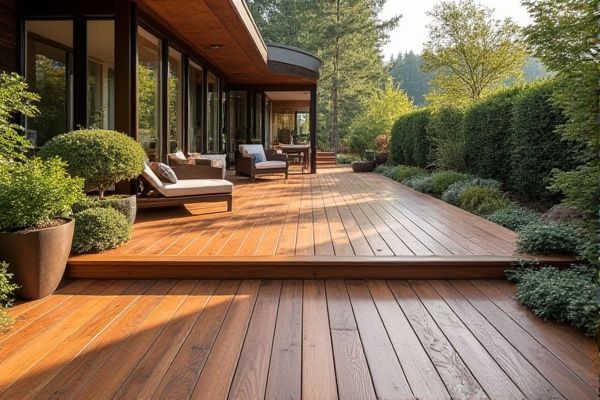
Composite decking offers superior durability, low maintenance, and resistance to rot, insects, and weathering compared to traditional wood decking, which provides natural beauty but requires regular sealing and upkeep. Explore the detailed comparison to determine which decking option best suits Your outdoor living space needs.
Table of Comparison
| Feature | Composite Decking | Wood Decking |
|---|---|---|
| Material | Made from recycled wood fibers and plastic | Natural hardwood or softwood |
| Durability | Highly durable, resistant to rot, insects, and warping | Prone to rot, insect damage, and warping over time |
| Maintenance | Low maintenance; requires occasional cleaning | High maintenance; requires staining, sealing, and regular upkeep |
| Cost | Higher initial cost but lower lifetime cost | Lower initial cost but higher lifetime maintenance cost |
| Appearance | Consistent color and texture; available in various styles | Natural look with unique grain patterns and aging |
| Environmental Impact | Uses recycled materials; eco-friendly | Harvesting may impact forests; biodegradable |
| Lifespan | 25-30 years or more | 10-15 years with proper maintenance |
| Installation | Easy to install with hidden fasteners | Requires nails or screws; may need professional installation |
Introduction to Composite vs Wood Decking
Composite decking offers enhanced durability and low maintenance compared to traditional wood decking, which is prone to rot, splintering, and insect damage. Made from a blend of wood fibers and recycled plastics, composite decking resists fading and warping while mimicking the natural appearance of wood. Wood decking, typically crafted from cedar, redwood, or pressure-treated pine, provides a classic aesthetic but requires regular staining and sealing to preserve its longevity.
Material Composition and Manufacturing
Composite decking consists of a blend of wood fibers and recycled plastic, engineered to resist rot, insects, and weathering, while wood decking is made from natural timber such as cedar, redwood, or pressure-treated pine, known for its authentic appearance and grain patterns. Composite boards undergo a manufacturing process that includes extrusion or molding, which enhances durability and color consistency, whereas wood decking is milled from logs and requires treatments like staining or sealing to protect against moisture and UV damage. The synthetic components in composite decking reduce maintenance needs, contrasting with wood's susceptibility to warping, cracking, and decay without regular upkeep.
Aesthetic Differences and Design Options
Composite decking offers a sleek, uniform appearance with a wide range of color and texture options that mimic natural wood without the inconsistencies of knots or grain variations. Wood decking provides a classic, authentic look with natural grain patterns and the ability to stain or paint for customized finishes, but requires regular maintenance to preserve its aesthetic appeal. Your choice depends on whether you prioritize low-maintenance versatility or the timeless, organic charm of real wood.
Durability and Longevity
Composite decking offers superior durability and longevity compared to traditional wood decking, as it resists rot, warping, and insect damage due to its blend of recycled wood fibers and plastic. Wood decking, while aesthetically pleasing and natural, requires frequent maintenance such as sealing and staining to prevent decay, splitting, and weathering over time. High-quality composite decks can last 25-30 years or more with minimal upkeep, whereas wood decks typically have a lifespan of 10-15 years depending on the species and maintenance level.
Maintenance Requirements
Composite decking offers significantly lower maintenance requirements compared to wood decking, as it resists warping, splintering, and insect damage without the need for regular sealing or staining. Wood decking demands frequent upkeep, including sanding, staining, and sealing to prevent rot and weather-related deterioration. Choosing composite decking saves you time and effort by minimizing the routine care needed to keep your outdoor space looking pristine.
Environmental Impact and Sustainability
Composite decking is made from recycled wood fibers and plastic, significantly reducing landfill waste and deforestation compared to traditional wood decking. Its durability and resistance to rot and insects decrease the need for chemical treatments and frequent replacements, lowering environmental impact over time. Wood decking, while biodegradable and often renewable when sourced responsibly, typically requires more maintenance, treatments, and has a higher carbon footprint due to harvesting and transportation.
Cost Comparison: Upfront and Long-Term
Composite decking generally has a higher upfront cost, ranging from $30 to $45 per square foot, compared to wood decking's $15 to $25 per square foot. However, composite decking offers lower long-term expenses due to minimal maintenance requirements and increased durability, whereas wood decking often incurs ongoing costs from staining, sealing, and repairs. Over a 15- to 20-year period, composite decking can prove more cost-effective despite the initial investment.
Installation Process and Considerations
Composite decking offers a streamlined installation process with pre-manufactured boards that resist warping and splitting, reducing the need for frequent maintenance compared to traditional wood decking. Wood decking requires careful handling during installation to prevent cracking and twisting, with considerations for sealing and regular treatment to maintain durability against weather elements. Your choice may depend on the ease of installation and long-term upkeep preferences, with composite decking often favored for its durability and simplified assembly.
Safety and Comfort Features
Composite decking offers superior safety features with its slip-resistant surface and resistance to splinters, making it ideal for family-friendly outdoor spaces. Wood decking provides natural warmth and comfort but requires regular maintenance to prevent splinters and surface degradation that can compromise safety. Both materials vary in temperature retention, with composite decking often staying cooler underfoot, enhancing comfort during hot weather.
Final Verdict: Choosing the Right Decking Material
Composite decking offers superior durability, low maintenance, and resistance to rot, insects, and fading, making it ideal for long-term investment. Wood decking provides natural beauty and traditional aesthetics but requires regular sealing, staining, and upkeep to prevent damage and decay. Selecting the right decking material depends on balancing budget, maintenance willingness, and desired appearance for your outdoor space.
 homyna.com
homyna.com